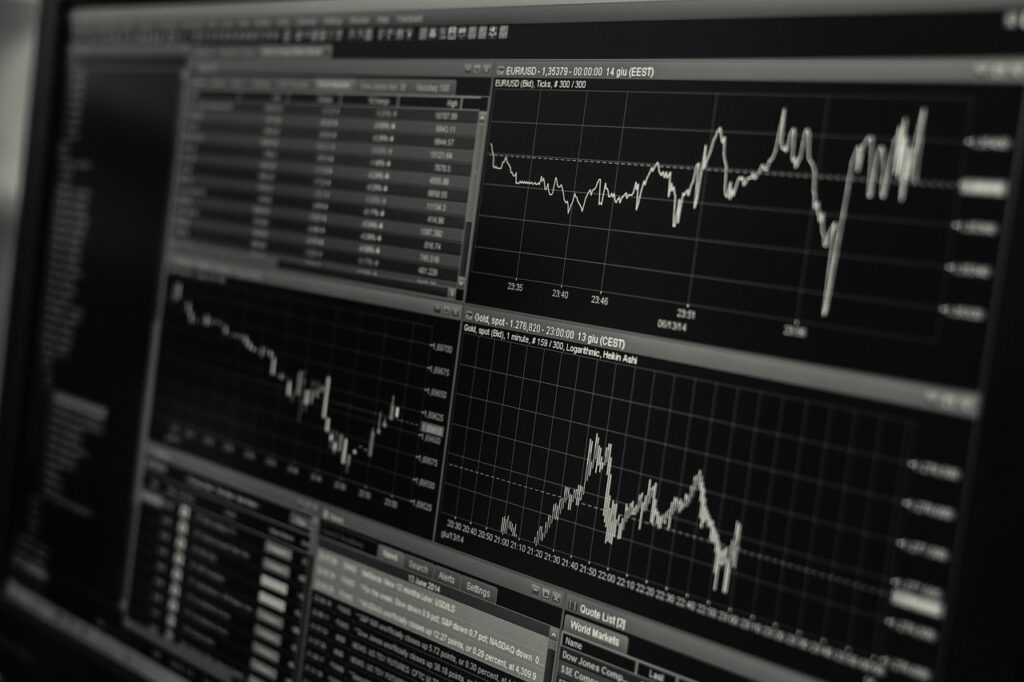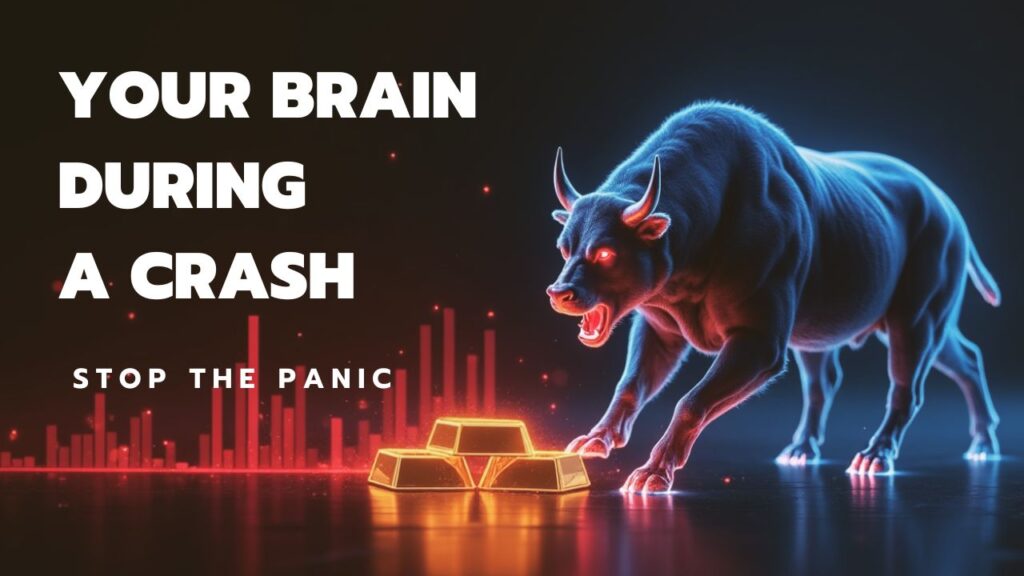When Stock markets crash, logic disappears. Fear takes the driver’s seat, and your survival instincts kick in. This article breaks down the psychology behind panic selling and how understanding your brain can help you stay calm when stocks drop.
“Fear is not a market condition. It’s a human condition and the best traders learn to master it.”
Shahzaib Khan
When the market turns red, logic disappears.
The same person who once swore they’d “buy the dip” now watches the screen frozen heart pounding, palms sweating, cursor hovering over the sell button.
Why do smart people panic when stocks fall?
The answer has less to do with money and more to do with the human brain. Let’s break down what really happens inside you during a market crash and how to stop it before it wrecks your portfolio.
Loss Aversion: Why Losing Hurts So Much
In behavioral finance, there’s a concept called loss aversion. Coined by Daniel Kahneman and Amos Tversky, it means we feel the pain of a loss about twice as strongly as the joy of a similar gain.
You lose $1,000 and it hurts far more than the excitement of making $1,000.
That’s the first reason market drops sting so deeply. Our brains evolved to treat losses as threats to survival. When early humans lost food or shelter, it meant danger.
Now, when traders lose money, the same neural circuits fire, especially the amygdala, the brain’s fear center.
That’s why even paper losses can trigger anxiety. It’s not about money anymore. It’s about safety.
The Brain on Market Stress
Here’s what neuroscience tells us:
When you see red candles or a crashing portfolio, your amygdala activates, the same system that reacts to physical danger. This triggers the fight-or-flight response, flooding your body with adrenaline and cortisol.
- Adrenaline raises your heart rate and sharpens attention, good for survival, bad for patience.
- Cortisol spikes make you more risk-averse and emotional, terrible for decision-making.
A 2014 study in Proceedings of the National Academy of Sciences found that higher cortisol levels made traders more likely to avoid risk. That means the very hormone designed to protect you ends up pushing you toward panic selling.
You’re not weak. You’re just human, running on outdated hardware in a modern financial system.
In the short run, the market is a voting machine, but in the long run, it is a weighing machine.”
Benjamin Graham
Herd Behavior: Why Fear Spreads Like Fire
Ever noticed how market fear feels contagious?
One trader panics, posts about it on X or Reddit, and suddenly, everyone’s rushing for the exit.
That’s herd behavior, our ancient instinct to copy others under uncertainty. When survival was at stake, following the crowd increased our odds of staying alive. In markets, it does the opposite.
Research on social contagion shows that emotions like fear spread faster than facts. During a selloff, traders don’t just respond to price data, they respond to other traders’ fear.
The result? A feedback loop of panic.
Even professional investors aren’t immune. Many sell not because they’ve re-evaluated fundamentals, but because they can’t stand watching everyone else sell.
Rational Investor Behavior vs Emotional Investor Behavior
| Situation | Rational Investor | Emotional Investor |
|---|---|---|
| Market drops 10% | Reviews fundamentals, stays calm | Panics, sells impulsively |
| Market rallies | Rebalances portfolio | Buys out of FOMO |
| News headlines | Looks for data | Reacts emotionally |
The Media and Margin Call Effect
The media amplifies fear.
“Markets in turmoil.” “Stocks plunge.” “Investors flee to safety.”
These headlines trigger emotional responses, not rational thought.
At the same time, margin calls and leverage add real pressure.
If you’re trading on borrowed money, every drop multiplies stress.
You’re not just losing capital, you’re facing forced liquidation.
That combination, fear + leverage + media panic, can push even seasoned traders into irrational decisions.
Also read: How to Stay Calm During Drawdowns
The Physiology of Panic Selling
Panic selling isn’t purely psychological, it’s biological.
Cortisol and adrenaline create measurable physical symptoms:
- Rapid heartbeat
- Shallow breathing
- Tight chest
- Tunnel vision
- Urge to act immediately
In that state, your prefrontal cortex (responsible for logic and planning) shuts down. You literally lose access to rational thinking.
So when people say “keep calm” during a crash, it’s not just advice, it’s neuroscience.
You can’t think clearly until your body calms down first.
Takeaway: Panic isn’t a sign of weakness, it’s your brain’s survival instinct misfiring in the modern market.

Emotion Regulation: The Science of Staying Cool
Fortunately, emotion regulation can rewire how you respond to losses.
In a 2013 study from Social Cognitive and Affective Neuroscience, researchers found that reappraisal, reframing how you think about losses reduced amygdala activity and made traders less loss-averse.
That means you can literally train your brain to handle volatility.
Practical emotion-regulation tools include:
- Pre-defined trading rules: When you know exactly when to exit, there’s no space for panic.
- Journaling: Writing about your trades reduces emotional charge and builds awareness.
- Breathing routines: Slow, intentional breathing lowers cortisol and restores clarity.
- Visualization: Picture volatility as “noise,” not danger, it changes your physiological response.
These aren’t fluffy techniques. They’re proven ways to deactivate fear circuits and regain control.
How to Build a Panic-Proof Mindset
Managing panic isn’t about eliminating fear. It’s about creating systems that make emotion irrelevant.
Here’s how top traders do it:
- Position sizing: Never risk more than what your nervous system can tolerate.
If a single trade can ruin your sleep, it’s too big. - Risk boundaries: Define loss limits before you enter a trade.
You can’t panic-sell if the decision was already made logically. - Detach from the screen: Constant monitoring fuels anxiety.
Set alerts and walk away, the market doesn’t move faster because you’re staring. - Shift identity: See yourself as a risk manager, not a gambler.
Professionals control exposure. Amateurs chase recovery. - Reflect after volatility: Every drop is data. Write down what you felt, how you reacted, and what you’ll change next time. That’s how you turn panic into discipline.
Why Emotional Discipline Is the Real Edge
Charts, algorithms, and data help, but they don’t protect you from yourself.
Emotional discipline does.
When everyone’s panicking, your ability to stay calm is your alpha.
You’re not competing against the market, you’re competing against your own biology.
Think about it this way:
If you can stay composed when others are dumping out of fear, you get to buy quality assets at irrational discounts.
The emotional pain others avoid becomes your opportunity.
That’s what separates the emotional trader from the evolved one.
Read this: The Role of Journaling in Trading Psychology
Turning Fear Into Focus
The market doesn’t punish fear, it punishes reaction.
Fear is information. It’s your brain’s way of saying, “Hey, this matters.”
If you can notice it without acting on it, you gain awareness instead of anxiety.
Use fear as a cue to slow down, not speed up.
- When volatility spikes, pause.
- Ask yourself: “What’s the actual risk here? What’s just emotion?”
- Revisit your plan. If the fundamentals haven’t changed, neither should you.
This mindset shift from reacting to responding, is the real skill behind trading longevity.
Key Takeaways for Traders
| Concept | What It Means | How to Counter It |
|---|---|---|
| Loss Aversion | Losses hurt twice as much as gains feel good | Reframe losses as cost of doing business |
| Cortisol Response | Stress hormones make you risk-averse | Breathe, move, or step away before acting |
| Herd Behavior | You copy others under uncertainty | Trade your plan, not the crowd |
| Media Amplification | Headlines fuel panic | Limit screen time during crashes |
| Emotion Regulation | You can train calm responses | Use routines, journaling, and visualization |
Final Thoughts: You’re Wired to Panic But You Can Rewire
Market panic isn’t a flaw in your character, it’s a survival response.
But survival instincts were built for jungles, not stock charts.
Your goal isn’t to suppress emotion but to train it.
When fear rises, awareness must rise faster.
That’s how you evolve from emotional trading to intelligent risk-taking from panic to purpose.
If you found this helpful, explore more mindset guides on The Reborn Trader. Want to master emotional control in trading? Join my free weekly newsletter where I share lessons from real traders who overcame fear and chaos.
FAQs
Why do investors panic when the stock market drops?
Investors panic because the brain perceives financial losses as threats, triggering fear-based responses like selling too soon. Behavioral finance explains this through biases like loss aversion and herd mentality.
What is stock market psychology?
Stock market psychology refers to the emotional and cognitive factors that influence investors decisions. It includes fear, greed, overconfidence, and mental biases that often lead to irrational behavior in trading.
How do long-term investors stay calm during market crashes?
Long-term investors focus on fundamentals, historical patterns, and the power of compounding. They create a plan, manage emotions, and avoid reacting to short-term volatility.
Is emotional investing bad for your portfolio?
Yes. Emotional investing often leads to buying high during euphoria and selling low during panic. Successful investing requires emotional discipline and sticking to a strategy regardless of market sentiment.
Why does Tesla stock cause emotional reactions among investors?
Tesla stock is highly volatile and tied to the polarizing personality of Elon Musk. Its rapid price swings and media attention often amplify investor emotions like FOMO and fear.
What are the biggest psychological mistakes in investing?
The most common mistakes include loss aversion, recency bias, confirmation bias, and herd mentality. These lead to impulsive decisions that hurt long-term returns.
How do I develop emotional control in stock investing?
To build emotional discipline, create a written investment plan, journal your decisions, zoom out on market trends, and limit media noise. Practicing mindfulness also helps reduce fear and impulsivity.
What is behavioral finance and how does it affect investors?
Behavioral finance studies how psychological biases impact financial decisions. It shows why rational investors still make poor choices under stress, especially during market volatility.
Why is patience important in investing?
Patience allows you to ride out short-term volatility and benefit from long-term growth. Many legendary investors attribute their success to holding quality assets through uncomfortable periods.
How do stocks like NVIDIA, Amazon, and SPY test investor psychology?
These stocks are popular and often experience big swings based on earnings, news, or economic factors. Their visibility makes them emotional triggers for both fear and hype-driven investing.




